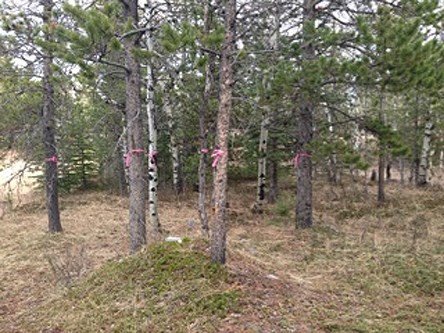New staff accommodations being put into Bow Valley Provincial Park (BVPP) have some residents concerned.
New staff accommodations being put into Bow Valley Provincial Park (BVPP) have some residents concerned.
Jeannette Hall, who currently lives in BVPP with her boyfriend, is worried Alberta Parks staff is “overlooking and mismanaging legislation and ecological evidence ” in order to put the accommodations in a Wildlife Habitat Patch and Corridor zone, rather than the approved Facility zone where she resides.
Jill Sawyer, regional communications officer with Alberta Environment and Parks, said the government is merely completing a project that was approved in the 1980s, which is in fact within the Facility zone.
Sawyer said the accommodations will be used for seasonal staff and will likely be completed ahead of the park's busy season in the spring.
Where the discrepancy lies is within legislation drafted in 1982 when the utility lines were initially installed and the sites were reportedly cleared and legislation passed in 1986, which doesn't reference the expansion.
“The facility zone has been there since the early 80s, it was established then. When it was established, we put in place some measures in case we needed to add some additional staff housing to that. When we did that we ran utility lines into two sites that didn't have housing on them at that time - all we're doing right now is putting mobile homes onto those two sites, ” Sawyer explained.
“The Draft Resource Management Policy (for Kananaskis Country) was released in August of 1982 and still subject to public and government review. The document was refined and revised based on public reaction. The next step of the planning process was the creation of the Draft Plan, released in October 1984, which cited management guidelines, direction for the achievement of objectives. The guidelines of the draft indicate whether various land-use activities are permitted or not permitted. The final plan was released in 1986, The Kananaskis Country Sub-Regional Integrated Resource Plan, approved by the Economic Planning Committee of the Cabinet on March 4, 1986, ” Hall said.
The Kananaskis Country Sub-Regional Integrated Resource Plan goes on to state the planned additional facilities, which are: Ribbon Creek Alpine Village, Wedge Lake and Alpine Village cross-country ski trails, possible expansions to the Mount Kidd campground, expansion to the William Watson Lodge, and an expansion of the Elkwood campground to the south.
There also seems to be some discrepancy regarding where the Facility zone boundary actually lies.
“There may be a little bit of discrepancy between a map that was originally drawn in the early 1980s versus a map that we're going to put onto the landscape in 2016 with a GPS system and satellite and that kind of thing, you might get a little discrepancy in some boundaries. But these sites in particular were cleared in the 1980s and we ran the underground utility lines through them. So there shouldn't be confusion of what the intention was for those particular sites, ” Sawyer explained.
According to Sawyer, the preparations to finish this project began in early March when AB Parks sent a senior ecologist to walk the sites and ensure “there were no rare plants or anything like that would be disturbed. ” The ecologist also ensured the project was starting before the migratory bird season so there was no nesting taking place in the trees being removed.
The sites were reportedly cleared when the utility lines were installed in the 1980s but Hall claims the trees, which have now been cleared, were much older.
“They were like 99-cm circumference, so these were very old trees, ” Hall explained, who took photos of the trees marked to be cleared and of the stumps from trees already cleared.
Hall alleges the area the mobile units are being installed in is a crucial corridor that wildlife use to navigate through BVPP. The sites are going into a small, treed-in area adjacent to the Trans-Canada Highway which, Hall said, allows wildlife to get around a large campground nearby without crossing the highway.
“I feel the development will interfere with a heavily-used, narrow wildlife corridor or ‘greenbelt.' It is only a few 100 meters at the most in width but is the only piece of BVPP North that isn't bisected by a human disturbance, ” Hall said.
“It is my observation that in the summer when the campground, trails, and summer camps are at max capacity, wildlife such as bears, foxes, cougars, lynx, deer, elk, rabbits, martins and bobcats move between the two quiet areas of the park along this ‘green belt.' ”
“We're definitely not putting housing into a wildlife corridor, and we've established that with our maps and environmental review, ” Sawyer said.
“We take it seriously when people have questions about our process and want to know how we arrived at all of these decisions. In this case, we spent a lot of time looking into all the questions and making sure they're all answered, ” Sawyer continued.
For now the disagreement remains unresolved as the project pushes forward. Hall maintains that she, and the data she has independently collected on the subject, is correct.
“When Alberta government managers and ecologists conduct poor site assessments, don't follow Alberta assessment standards, fail to conduct required wildlife impact studies, give misleading and wrong information about a site and can't clearly answer questions, they degrade the credibility of the science, data and all other environmental professionals. As an environmental professional myself, I would call this blatant negligence.
“I have thousands of photos of wildlife (in the sites), even one with a pile of bear scat next to a tree marked. On what evidence do these ecologists base their assumptions, ” Hall said.
More information about the project and the public consultation process can be found at www.albertaparks.ca
